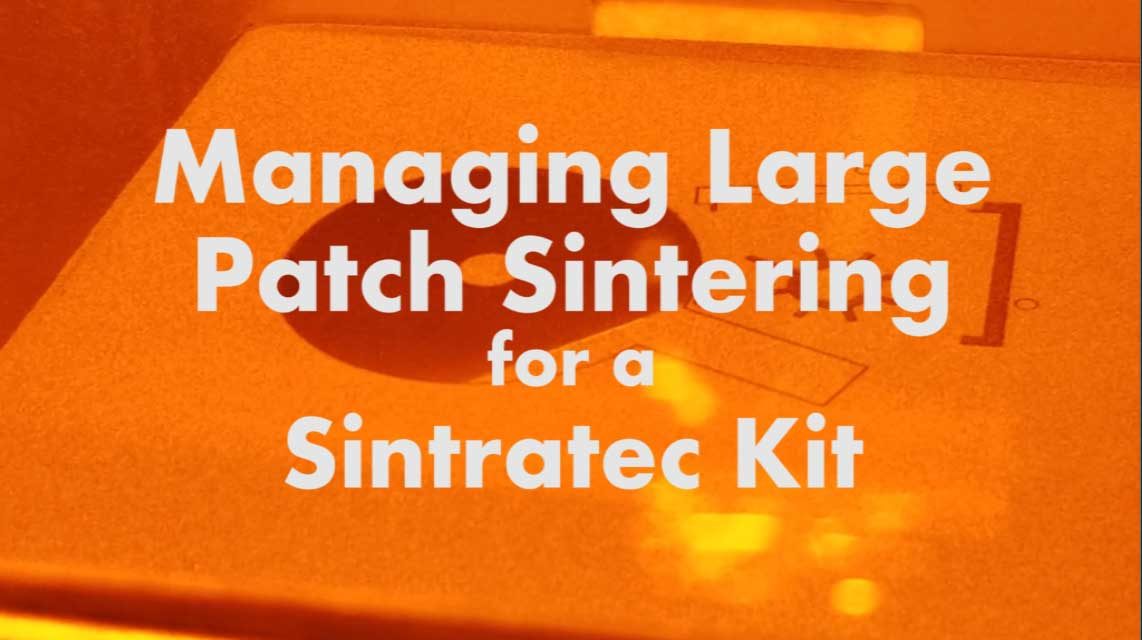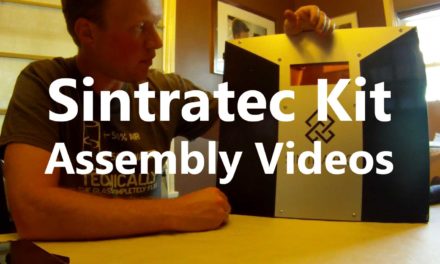While pumping out model after model after model in the last few weeks, we’ve noticed some interesting results with the Sintratec Kit. For the most part, everything is going really well, and we are calibrating this beauty to work with varying powder ratios. We are pushing the limit to what the machine can do, and it’s exceeding the Sintratec official recommendations.
In some cases though, we are getting a few oddball issues. Notably, when we are trying to sinter large swaths of powder exceeding six layers, the applicator fin cannot fully refill the crater created by the sintered cross-section. After a while, the bed can get this receding powder problem and if the area is large enough, it can allow the sintering to overlap previously-sintered patches.
Sintratec anticipates this problem, and recommends that users orient their geometry in Sintratec Central so that no portion of any STL has a cross-section that is really big. There isn’t any specifics on what that means, like how many square-millimeters would constitute an unviable job, but most Sintratec users have a tacit understanding of what they mean.
We wanted to explain this issue in more detail and recorded a portion of a recent large build (approximately 940 layers) to show that I encountered not just “receding powder” on the job, but with enough layers, it even receded into the sintered cross-section as well. This is essentially a failed print. But once we started editing the video, the receding behavior didn’t show up well on camera. We wrote a few MEL scripts and animated a short video to exaggerate the powder and sintering depths to better express what we encountered. Check our animation out:
Fun stuff. The MEL script was pretty simple. Basically, the laser “line” had a CV that I used to get the pointPosition and check that against all the neighboring mesh vertices. The script plots a path on the sintering polyline (breaking up each line-segment into equal sections to ensure the animation of the laser is fluid) and it keyframes the movement of vertices to simulate “melting.” It just simultaneously keyframes the laser lower CV as well. Once it’s all done, the keyframing is scaled with a variable in the code to stretch the animation out if necessary. The rest of the animation and modeling was just basic Maya stuff. I probably spent 2 hours on the script and even less time manually animating the virtual Sintratec case.
Back to the topic, there are some solutions to prevent powder recession.
First, if you don’t want to rock the boat, just listen to Sintratec. Don’t sinter large areas. Rotate your models so that they don’t appear to have large surfaces. Also, check the Sintratec Central “Preview” whenever you load a model, to ensure you don’t have any large patches, overlaps, malfunctions, and other potential problems.
If you are interested in pushing it, you can always just print it anyway. If you know you won’t have more than one or two potential double-sintered sections, then it will probably be fine as is. If your model isn’t going to be load bearing or in tensile occupation or other structural necessity, then for show, it might ok. However, if you have several layers of this sintering on top of each other, it’s probably not going to work for you.
One way to fix that is, move your model closer to the right side of the bed. This will force the first part of the powder to fill the crater, and then leave not much else for the left side. If you have mostly an empty bed with nothing to the left of the large area, then you could be ok here as well. However, everyone should attempt to fill the bed as much as possible to ensure a full utilization of the powder. Printing one object in the bed is a huge waste of powder.
Another thing to do is make sure that if you have more than one model in the bed, move your large cross-section to the right, and don’t put anything to the left of the problem cross-sections. At any given large patch cross section, move the secondary models up or down in elevation. That way, when you sinter the large swaths, there isn’t anything residing on the left starving for powder.
Plugin:
Given all this new knowledge, we are working on a CATIA analysis plugin that will report issues based on various printing criteria.
- Cross-sectional problem areas (by layer)
- Geometry that could potentially reside in a powder recession
- Geometry that could warp due to uneven powder to the left of a large patch
- Double Sintering risks (based on number of layers)
- Relative location risk (left vs right)
Whenever we set up a new bed layout in Maya or CATIA, we’ll run our tool to ensure that we won’t have any STL’s in danger of falling into that criteria. It’s not a complicated tool to create in CATIA, however, it’s a PITA to export my Maya layout back into CATIA to do the analysis. Ideally, I’d rather have this written in Maya MEL, because I use our Maya exporter to Sintratec Central to prep these for printing. I don’t want to return all the way back to CATIA to run the analysis.
Either I have to decide if I rewrite this all in MEL (which the area calcs alone are going to be a huge PITA), or I figure out a way to author a C#.net command module that connects to CATIA via COM or marshalling and does the analysis in a hidden session of CATIA, closes out CATIA, and returns all the analysis data as a representational set of lines or meshes on top of my Maya model. IDK. I got some time to figure it out.




![[0001D] | How “Mega-Dots!” Puzzles Got Started](https://www.nickpisca.com/sherpa/wp-content/uploads/2015/06/PA218118_Generic.jpg)
Recent Comments